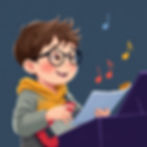
The Benefits of Music for Children with Autism: How Music Therapy Can Improve Development
Aug 30
2 min read
1
17
0

Music therapy has been increasingly recognized as a valuable tool in supporting the development of children with Autism Spectrum Disorder (ASD). Research has shown that music therapy can have a profound impact on the social, emotional, and cognitive development of children with autism, helping them to communicate more effectively, build relationships, and manage their emotions.
How Music Therapy Works for Children with Autism
Music therapy for children with autism typically involves the use of music to achieve specific therapeutic goals, such as improving social skills, enhancing communication, and reducing anxiety. Music therapists work with children with autism to create a personalized music program that meets their unique needs and goals.
Benefits of Music Therapy for Children with Autism
Improved Social Skills: Music therapy can help children with autism develop social skills, such as turn-taking, sharing, and cooperation. Through music-making activities, children can learn to interact with others in a more meaningful way.
Enhanced Communication: Music therapy can help children with autism communicate more effectively, both verbally and non-verbally. Singing, playing instruments, and moving to music can provide a means of expression and communication.
Reduced Anxiety and Stress: Music therapy can help children with autism manage their anxiety and stress levels, promoting relaxation and calmness. The soothing effects of music can be particularly beneficial for children who experience sensory overload.
Increased Emotional Intelligence: Music therapy can help children with autism develop emotional intelligence, including recognizing and understanding emotions in themselves and others.
Improved Cognitive Function: Music therapy can help children with autism improve their cognitive function, including attention, memory, and processing skills.
Examples of Music Therapy Activities for Children with Autism
Singing Songs: Singing songs with repetitive melodies and lyrics can help children with autism develop language skills and improve communication.
Playing Instruments: Playing instruments, such as drums or maracas, can help children with autism develop fine motor skills and hand-eye coordination.
Movement Activities: Movement activities, such as clapping or marching to music, can help children with autism develop gross motor skills and coordination.
Improvisation: Improvising music can help children with autism develop creativity and self-expression.
Conclusion
Music therapy is a valuable tool in supporting the development of children with autism. By providing a means of communication, social interaction, and emotional expression, music therapy can help children with autism overcome some of the challenges associated with the disorder. If you're considering music therapy for a child with autism, look for a qualified music therapist who can tailor a program to meet their unique needs and goals. With the right support, music therapy can be a powerful tool in helping children with autism thrive.
Solution?
Point de Mire Music's Art and Wellness program offers a unique music therapy solution for children with Autism Spectrum Disorder (ASD). Our tailored programs focus on improving social skills, communication, and cognitive function while reducing anxiety. Experienced music therapists create personalized programs, fostering creativity and growth. Music therapy sessions encourage social interaction, expression, and relaxation, making a significant difference in a child's development and well-being. Our goal is to provide a comprehensive and effective music therapy program that meets each child's unique needs, helping them reach their full potential and live a more fulfilling life!





